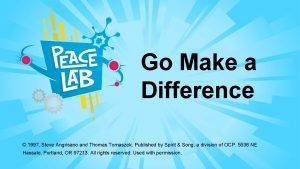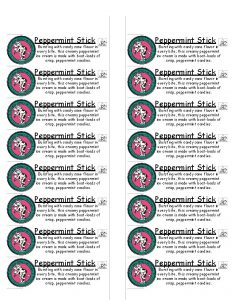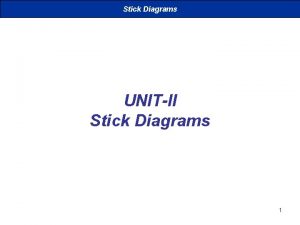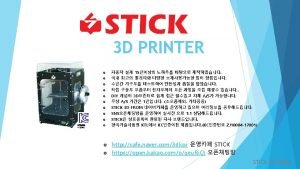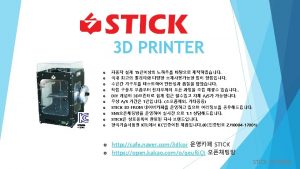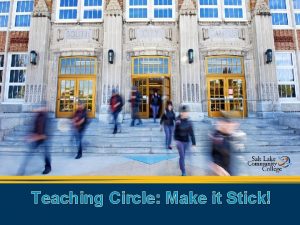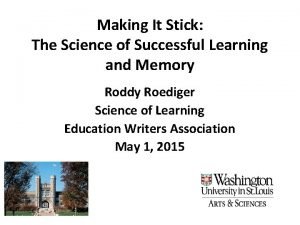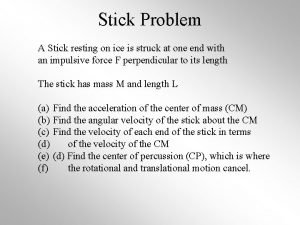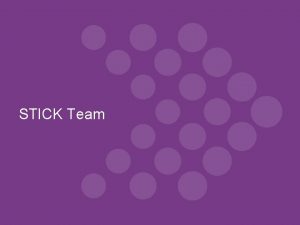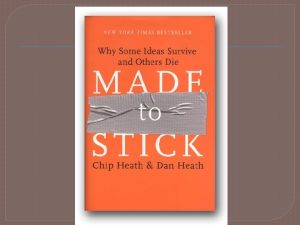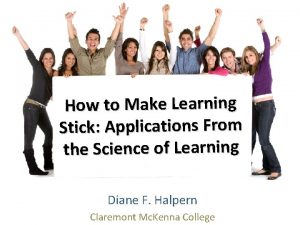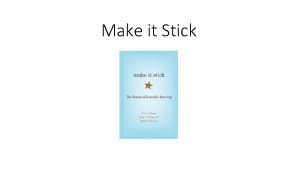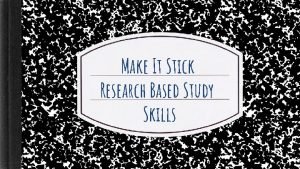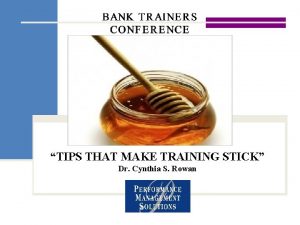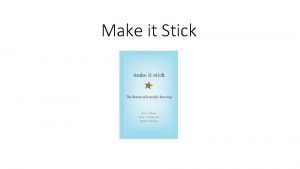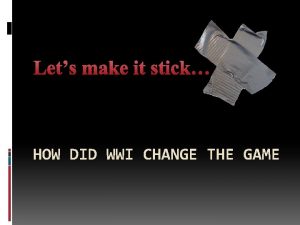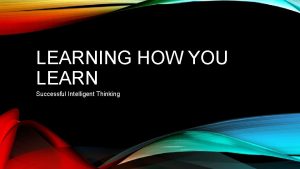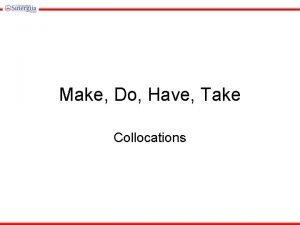MAKE IT STICK THE SCIENCE OF SUCCESSFUL LEARNING
































- Slides: 32

MAKE IT STICK THE SCIENCE OF SUCCESSFUL LEARNING FACILITATED BY HEIDI KAMILAR ANALYSIS OF THE COGNITIVE SCIENCE OF LEARNING BOOK BY AUTHORS PETER C BROWN, HENRY L ROEDIGNER III, AND MARK A MCDANIEL Please find all materials at http: //ahmophysicsfun. weebly. com/ Make It Stick button at top right

MAKE IT STICK • by Peter C Brown, Henry L Roediger III, Mark A Mc. Daniel • 2014 • Belknap Press of Harvard University Press, Cambridge Massachusetts • ISBN 978 0 674 72901 8 • Analysis of Make It Stick by Milkyway Media available on Kindle

OVERVIEW • An introduction to cognitive science for readers who wish to enhance their individual learning process. • Authors Brown and Roediger participated in a 10 year granted study that analyzed education research and data and present it through the storytelling skills of novelist Mc. Daniel. • A light easy read that references all the data through interesting and compelling stories presented by modeling many of the suggested strategies.

AUTHOR’S BELIEFS • most people adapt unproductive learning practices because they appear to improve learning – book outlines data driven effective learning strategies. Desirable Difficulties Video: https: //makeitstick. net/ Get It Out to Get It In Video: https: //makeitstick. net/ • The brain has the capacity to change and develop over time allowing for new learning and adaptability. (neuroplasticity and a growth mindset) • Learning requires time, space between reviewing to interrupt the cycle of forgetting, desirable difficulty to deepen knowledge, application, and retention. Intuition Video: https: //makeitstick. net/

Book’s Structure • • Chapter 1 -5 Convince the reader that the listed Learning Strategies are effective Chapter 4 Embracing Difficulty dispels many misconception of parents and teachers that try to remove obstacles for their learners Chapter 5 Avoid Illusions of Knowledge encourages learners to truly evaluate knowledge and lists examples of illusion of mastery Chapter 6 Lists Research on all available difference in how people learn and how to improve weak areas Chapter 7 Explains Growth Mindset Chapter 8 Lists the Effective Learning Strategies stating that effortful learning changes the brain Notes list all the Researchers referenced for further study

STRENGTHS • Most relevant research is presented in an easy to use format • Great list of misconceptions of learning challenged and alternatives offered • Wonderful explanation of how to apply strategies listed • Good applications drawn for all stages of learners WEAKNESSES • Story format is effective and interesting but a bit cumbersome when searching for quick facts • Learning styles is gaining notoriety again since the book’s printing due to ed tech improvements • Not clear enough on 1) a small amount of Massed Practice is necessary prior to Interweaving 2) some memorizing is needed with Spaced Retrieval and Application • Does not address reluctant learners • Authors appear to believe the main mode of student learning is by reading a textbook.

Blended Learning Preferences and the Power of Choice • • Research does not supported teaching strictly according the student’s Learning Style. Instructional Choices should be driven by the needs of the content first and the desires of the student second. • some content must be taught with active engagement • some should be taught by direct instruction • some can be taught multiple ways with the same effectiveness. Allow students to choose how they want to learn when content can be taught with the same excellence independent of the modality The empowerment of the student’s choice could be the difference between noncompliance and a happy learner eager to apply

Blended Preference Learning Key Concepts http: //AHMOPhysics. Fun. weebly. com top right for training • • Organization is Key/Ready access to all resources Set and Present Clear Dailey, Weekly, etc Expectations • chart successfully meeting each expectations with ways to recover missed Meet with each student in small groups Keep It Simple • If students are selecting how they are learning then all are “out puting” in the same way or vise versa. • • Pre and Post assessment Weekly Low Stakes Quizzes to Assess knowledge • clear expectations and resources to relearn and retest concepts

Power of Choice and Learning Preferences 1) Choose what you want to learn about for the remainder of our session. Key Insights and Learning Strategies move to tables 1 -3; Educational Research at tables 4 -6; Wild Card at table 7 1) 2) 3) 4) Find the appropriate slides on the powerpoint and printed packets according to what your group has chosen to learn. Whiteboard the main ideas that are relevant to your classes and who you are as a teacher - it is ok to have different perspectives at the same group. Last 15 minutes each group will share their white boards with the group. All material is available at my site www. AHMOPhysics. Fun. weebly. com

KEY INSIGHTS: As a group, choose 1 -2 from the front of the room to discuss 1. Conventional assumptions about learning are deeply flawed. 2. Remembered knowledge is embedded in the mind more deeply than knowledge that is simply read over and over again. 3. Effective learning demands hard work and requires time. 4. Partial forgetting is integral to efficient learning. 5. Studying different information or skills in quick succession results in more efficient knowledge. 6. The brain is mutable. People control their abilities more than they think. 7. Failure is key to success. 8. Surface memory is a portal to deeper knowledge. 9. To most efficiently become experts in a field, learners must internalize information.

KEY INSIGHT 1 CONVENTIONAL ASSUMPTIONS ABOUT LEARNING ARE DEEPLY FLAWED. • Rereading leads to a false familiarity of the words not a true knowledge of the concept. • Data as old as 1960 s shows the inefficiency of rereading or reviewing highlighting after the first or second reading. • This feels like quick learning but this learning is superficial. • Reviewing of material must be completed with gaps of time in between (Spaced Retrieval) to allow the learner to forget a bit, struggle to remember, relearn and draw across to other topics.

KEY INSIGHT 2 Remembered knowledge is embedded in the mind more deeply than knowledge that is simply read over and over again. • People learn more efficiently by retrieving information via recall than by rereading the same text repeatedly. • Regular quizzing is more effective than reviewing notes • the act of trying to remember connects to prior knowledge and anchors knowledge more deeply into more long-term memory and allows a greater capacity for future knowledge to be applied.

KEY INSIGHT 3 Effective learning demands hard work and requires time. • Research shows that the best learning strategies require a process of trial and error that conflicts with the conventional wisdom that memorization and studying yield durable results. • learning by experience that is not totally scripted, by trial and error, learners are frustrated by data shows a yield of deeper and more enduring knowledge. • learning with ease and complete direction void of critical thought and student lead decisions leads to fragil memory and knowledge • learners must be open to failure and growing from mistakes for most effective learning.

KEY INSIGHT 4 Partial forgetting is integral to efficient learning. • Knowledge “sticks” when it is integrated and contextualized. • Integration requires time between reviewing the material • Effort exerted to remember the material connects the forgotten information to previous knowledge crystalizing the memory and transferring the memory from short term to long term memory

KEY INSIGHT 5 Studying different information or skills in quick succession results in more efficient knowledge. • Alternating subjects of study leads to stronger and deeper long term knowledge of a given disciple by training people to differentiate items within a larger whole. • forces the mind to look for similarities and differences as well as contextual • • cues embedding the new knowledge in a wider mental structure. feels combersum and does not feel effective but leads to deeper knowledge (Book states only briefly that the concepts must be practiced first to the level of understanding but not to the level of comfort before mixing problem types. )

KEY INSIGHT 6 The brain is mutable. (Neuroplasticity) People control their abilities more than they think. • • • The brain is not a static organ regardless of genetics and environment The brain can change and shift extending and developing its learning capabilities The more arduous the learning the more myelin sheath coating on the neurons which allows action potentials to jump quicker and increase performance. desirable difficulty during learning shifts knowledge to long term memory and storage in a subconscious portion of the brain. not so much nature vs nurture as continual learning increases learning (The book does not differentiate between the need for quick process thinking and slower analysis thinking required for different concepts)

KEY INSIGHT 7 Failure is KEY to success. • • • viewing abilities as limited results in avoiding failure, taking fewer risks in life, curbing learning understanding that you have control over your own intellectual abilities yields more effort to succeed in own desires failure is a necessary gateway to further growth grade requirement for programs opposes to the positivity of failing Programs highlighting the attributes of failures: Harvard’s Sucess Failure Project, Stanford’s Resilience Project and I Screwed Up Project, Smith’s Destigmatizing Failure Workshops, and U of Penn’s

KEY INSIGHT 8 Surface Memory is a portal to deeper knowledge • • memorizing is necessary for rudimentary knowledge which can then be deepened and applied Mnemonic Devices are helpful for remembering large quantities of understood, assimilated concepts

KEY INSIGHT 9 Learners must internalize information in order to become experts in a field. • • experts transfer deeply learned information to subconscious habits regular work on a topic causes the brain to • continually retrieve the knowledge • • • creating more and more neural connections contextualize and apply the knowledge assimilate the concept • extending the ability to learn related concepts

Effective Learning Strategies • • • Self-Quizzing Study Missed Quiz Questions Interleave Different Problem Types Spaced Retrieval Practices Elaboration Generation/Discovery Reflection Callibration/Assessment Mnemonic Devices/Memory Aids Packet includes • • • description how to implement Student Explanation that can be added to student assignments explaining your educational choices to students.

Research Says… How the Learner Views their Abilities (p 139 -142) • • • “Whether you think you can or you think you cant - youre right” Carol Dweck - the Growth Mindset states students must believe they can grow and improve (more in depth in chapter 7 What you tell yourself about your abilities plays a part in shaping the ways you learn and perform • how hard you apply yourself, • tolerance for risk-taking • your willingness to persevere in the face of difficulty

Research Says… Abilities That Shape Successful Learning (p 141 -143) • • Differences in skills, aptitudes, intelligence Differences in prior knowledge, interests, sense of personal empowerment ability to convert new knowledge and mental structures into building blocks for further learning language fluency and reading ability

Research Says… Desirable Difficulties Deepen Understanding (141 -143) • • • difficulties that require increased cognitive effort can strengthen learning difficulties that do NOT contribute to more robust learning is NOT desirable difficulties • grasp the big picture rather than stop at the struggle with the details • how to think outside the box • how to think/act strategically • how to manage risk taking • overcome or work with the fear of failure

• Research Says… Learning Styles are misused (143 Assessment of learning styles is recommended at all levels of education, management development, and at vocational and professional trainings • 2004 research compares 70 different learning style theories yielding a “bedlam of contradictory claims” that lead to classification, label, and stereotyping and diminished potential Students may think the results of the assessment state the limits of how they should learn • • “While it is true that most all of us have a decided preference for how we like to learn new material, the premise behind learning styles is that we learn better when the mode of presentation matches the particular style in which an individual is bet able to learn. ” • 2008 review of research on Learning Styles found that no current research analytically compared the presentation of information within the preferred learning style of the student.

Research Says… Learning Styles Importance (143 -146) • The fact that learning preferences are widely accepted and no current research evaluates the validity of learning styles theory shows that more scientific research should be conducted • “It is more important than the mode of instruction match the nature of the subject being taught” • visual instruction for understanding a shape in geometry • verbal instruction for poetry • experiential for lab skills • When instructional style matches the nature of the content all learners learn better regardless of their differing preferences for how the material is taught. • [see blended preference learning for concepts that can be taught in several modalities]

Research Says… Successful Intelligence (146) • Psychologists generally accept there are 2 kinds of intelligence • • Fluid Intelligence = the ability to reason, see relationships, think abstractly, and hold information in mind while working ona problem Crystallized intelligence is ones accumulated knowledge of the world and the procedures r mental models one has developed from past learning and experiences. • • together these two kinds of intelligences enable us to learn, reason, and solve problems Traditionally, intelligence was thought to be fixed at birth • current research is challenging this

Research Says… Multiple Intelligence (147 -150) • Psychologist Howard Gardner = 8 different kinds of observable intelligences • • • Psychologist Robert J Sternberg = 3 kinds of intelligences is supported by data • • Logical Mathematical, Spatial, Linguistic, Kinesthetic, Musical, Interpersonal, Intrapersonal, Naturalistic is a tool for educator and learner to select the learning environment “determining one’s mix of intelligences is more an art than science” lacks research with empirical validation analytical, creative, and practical are shaped by the values of their environment “We’re all in a state of developing expertise, any test that measures only what we know at any given moment is a static measure that tells us nothing about our potential. ” “Traditional measure of intelligence failed to account for environmental differences; there is no reason to suspect that kids who excelled at informal, indigenous knowledge can’t catch up or even surpass their peers in academic learning when given the appropriate opportunities. ” Different cultures and learning situations draw on intelligences differently, and much of what’s required to succeed in a particular situation is not measured by standard IQ test, which can miss critical competencies.

Research Says… Dynamic Testing (151) • Psychologist Howard Gardner = 8 different kinds of observable intelligences • • • Psychologist Robert J Sternberg = 3 kinds of intelligences is supported by data • • Logical Mathematical, Spatial, Linguistic, Kinesthetic, Musical, Interpersonal, Intrapersonal, Naturalistic is a tool for educator and learner to select the learning environment “determining one’s mix of intelligences is more an art than science” lacks research with empirical validation analytical, creative, and practical are shaped by the values of their environment “We’re all in a state of developing expertise, any test that measures only what we know at any given moment is a static measure that tells us nothing about our potential. ” “Traditional measure of intelligence failed to account for environmental differences; there is no reason to suspect that kids who excelled at informal, indigenous knowledge can’t catch up or even surpass their peers in academic learning when given the appropriate opportunities. ” Different cultures and learning situations draw on intelligences differently, and much of what’s required to succeed in a particular situation is not measured by standard IQ test, which can miss critical competencies.

Research Says… Dynamic Testing vs Standardized Tests (151 -152) • proposed by Robert Sternberg & Elena Grigorenko • (Step 1 Assessment) “determining the state of one’s expertise; (Step 2 relearn) refocusing learning on areas of low performance; (Step 3 Reassess) follow-up testing; to measure the improvement ; and to refocus learning so as to keep raising expertise. ” • “tests assess a weakness as a lack of skill or knowledge that can be remedied. ” • “focuses the learner and teacher on areas that need to be brought up rather than on areas of accomplishment” • “the ability to measure a learner’s progress from one test to the next provides a truer guage of his or her learning. ” • “most can learn to perform nearer to our full potential in most areas by discovering our weaknesses and working to bring them up. ”

• Research Says… Structure Building the act, as we encounter new material, of extracting the salient ideas and constructing a coherent mental framework (mental models/mental maps) out of them. • high structure builders learn new material easily • low structure builders have difficulty setting aside irrelevant or competing information • • • (153 -155) resulting in hanging on to too many concepts to be condensed into a workable mdel that can serve as a foundation for further learning. is a form of conscious and subconscious discipline: stuff fits or it doesn’t; it adds nuance, capacity and meaning, or it obscures understanding of structure building is in early stages: is this due to faulty cognitive mechanisms or is it learned • embedded questions and reflection on learning gives low structure builders the tools they need to organize mental models and apply them again in the future.

Research Says… Rule vs Example Learning (155 -158) • Rule Learners tend to abstract the underlying principles or rules that • differentiate the examples being studied. Later they apply the rules as a means to classify it ans select the appropriate solutions. Example Learners tend to memorize the exampls rather than the underlying principles. When they encounter an unfamiliar case, they lack a grasp of the rules needed to classify or solve it so they generalize from the nearest example even if it is not particularly relevant to the new case. • increase identifying rules by asking students to compare and contrast two examples instead of studying one example at a time • understanding of Rule vs Example learners is in early stages • high structure rule learners are more successful in transferring their learning to unfamiliar • situations research is not available on weather high structure and rule learner tendencies are linked.

Resources • • • http: //Make. It. Stick. net Links, videos, research related to Educational Research http: //Retrieval. Pratice. org download free guides to Increase Retrieval Practices, Transfer of Learning, Interleaving Practices http: //Learning. Scientists. org Study Strategies Posters, Videos, Slideshow for Students Analysis of Make It Stick by Milkyway Media http: //AHMOPhysics. Fun. weebly. com Learning Strategies from Make It Stick by Heidi Kamilar
 What is your favorite lesson
What is your favorite lesson Cuadro comparativo e-learning y b-learning
Cuadro comparativo e-learning y b-learning Make the lie big
Make the lie big Go make a difference we can make a difference
Go make a difference we can make a difference Dawes plan
Dawes plan Hình ảnh bộ gõ cơ thể búng tay
Hình ảnh bộ gõ cơ thể búng tay Frameset trong html5
Frameset trong html5 Bổ thể
Bổ thể Tỉ lệ cơ thể trẻ em
Tỉ lệ cơ thể trẻ em Chó sói
Chó sói Thang điểm glasgow
Thang điểm glasgow Alleluia hat len nguoi oi
Alleluia hat len nguoi oi Môn thể thao bắt đầu bằng chữ f
Môn thể thao bắt đầu bằng chữ f Thế nào là hệ số cao nhất
Thế nào là hệ số cao nhất Các châu lục và đại dương trên thế giới
Các châu lục và đại dương trên thế giới Công thức tính thế năng
Công thức tính thế năng Trời xanh đây là của chúng ta thể thơ
Trời xanh đây là của chúng ta thể thơ Mật thư anh em như thể tay chân
Mật thư anh em như thể tay chân Làm thế nào để 102-1=99
Làm thế nào để 102-1=99 độ dài liên kết
độ dài liên kết Các châu lục và đại dương trên thế giới
Các châu lục và đại dương trên thế giới Thơ thất ngôn tứ tuyệt đường luật
Thơ thất ngôn tứ tuyệt đường luật Quá trình desamine hóa có thể tạo ra
Quá trình desamine hóa có thể tạo ra Một số thể thơ truyền thống
Một số thể thơ truyền thống Bàn tay mà dây bẩn
Bàn tay mà dây bẩn Vẽ hình chiếu vuông góc của vật thể sau
Vẽ hình chiếu vuông góc của vật thể sau Thế nào là sự mỏi cơ
Thế nào là sự mỏi cơ đặc điểm cơ thể của người tối cổ
đặc điểm cơ thể của người tối cổ V cc
V cc Vẽ hình chiếu đứng bằng cạnh của vật thể
Vẽ hình chiếu đứng bằng cạnh của vật thể Vẽ hình chiếu vuông góc của vật thể sau
Vẽ hình chiếu vuông góc của vật thể sau Thẻ vin
Thẻ vin đại từ thay thế
đại từ thay thế



